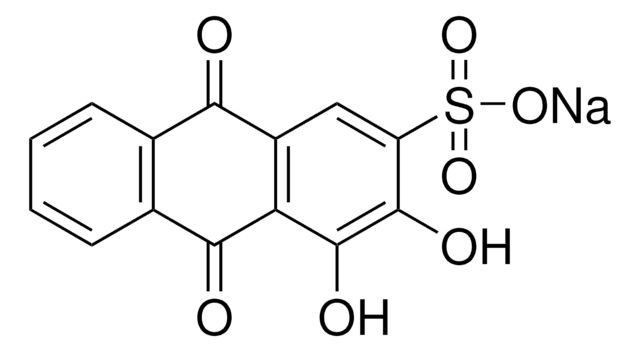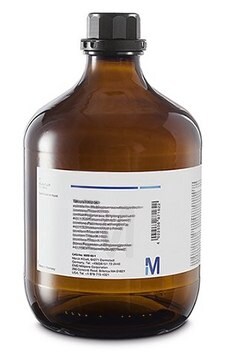8.40008
1-Cetylpyridinium chloride monohydrate
for synthesis
Sinónimos:
1-Cetylpyridinium chloride monohydrate, N-Hexadecylpyridinium chloride, 1-Hexadecylpyridinium chloride monohydrate
About This Item
Productos recomendados
Quality Level
form
solid
pH
5.0-5.4 (20 °C, 10 g/L in H2O)
mp
80-84 °C
bulk density
370 kg/m3
storage temp.
2-30°C
InChI
1S/C21H38N.ClH.H2O/c1-2-3-4-5-6-7-8-9-10-11-12-13-14-16-19-22-20-17-15-18-21-22;;/h15,17-18,20-21H,2-14,16,19H2,1H3;1H;1H2/q+1;;/p-1
InChI key
NFCRBQADEGXVDL-UHFFFAOYSA-M
Application
- Reduction of bacterial contamination in meat processing: Cetylpyridinium chloride was used as an antimicrobial agent on beef hides, demonstrating significant effectiveness in reducing bacterial contamination, which is crucial for food safety in meat processing industries (Baird et al., 2006).
- Antibacterial effects in dental materials: The dentin primer containing cetylpyridinium chloride in Clearfil Protect Bond showed notable antibacterial effects against oral pathogens, suggesting its potential use in enhancing the antimicrobial properties of dental restorative materials (Imazato et al., 2006).
- Antimicrobial activity on frankfurters: Cetylpyridinium chloride was effective in controlling Listeria monocytogenes on frankfurters, highlighting its role in improving food safety and extending shelf life in processed meat products (Singh et al., 2005).
- Chemical treatment of periodontally involved root surfaces: A study utilized cetylpyridinium chloride in a chemical treatment modality for periodontally involved human root surfaces, illustrating its effectiveness in root surface preparation for dental procedures (Okte and Bal, 2000).
Analysis Note
Water (K. F.): 4.5 - 5.5 %
Identity (IR): passes test
signalword
Danger
Hazard Classifications
Acute Tox. 2 Inhalation - Acute Tox. 4 Oral - Aquatic Acute 1 - Eye Dam. 1 - Skin Irrit. 2 - STOT SE 3
target_organs
Respiratory system
Storage Class
6.1A - Combustible, acute toxic Cat. 1 and 2 / very toxic hazardous materials
wgk_germany
WGK 3
flash_point_f
Not applicable
flash_point_c
Not applicable
Certificados de análisis (COA)
Busque Certificados de análisis (COA) introduciendo el número de lote del producto. Los números de lote se encuentran en la etiqueta del producto después de las palabras «Lot» o «Batch»
¿Ya tiene este producto?
Encuentre la documentación para los productos que ha comprado recientemente en la Biblioteca de documentos.
Nuestro equipo de científicos tiene experiencia en todas las áreas de investigación: Ciencias de la vida, Ciencia de los materiales, Síntesis química, Cromatografía, Analítica y muchas otras.
Póngase en contacto con el Servicio técnico


![Sodium nitroprusside dihydrate [disodium pentacyanonitrosyl ferrate(III) dihydrate] GR for analysis ACS,Reag. Ph Eur](/deepweb/assets/sigmaaldrich/product/images/350/751/c4f466f3-0750-4cb4-af8f-5942eba5d12f/640/c4f466f3-0750-4cb4-af8f-5942eba5d12f.jpg)




